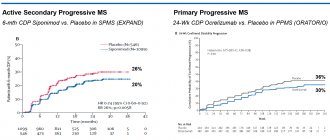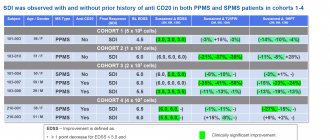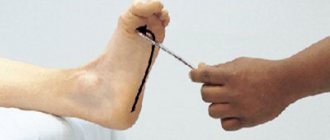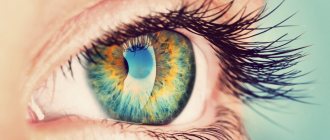The most important symptom of cerebellar damage is cerebellar ataxia, which is characterized by a symptom such as asynergia (Babinski) of both general and individual movements, that is, the inability to coordinate individual muscle contractions in order to carry out complex motor acts, for example, walking (cerebellar “drunk” gait). In some cases, there is a tendency to fall to one side (predominantly the affected side).
This also includes the so-called hypermetry, which is a disproportion of movements during the implementation of a certain action, for example, instead of touching the nose with the tip of a finger, the patient hits it with force into the adjacent part of the face (against the background of asynergia).
Symptoms such as muscle hypotonia and disorders of coordination of movements and statics characterize damage to the cerebellum. These disorders are characteristic of all vertebrates. Since the symptoms of cerebellar damage are of particular importance in medicine, they are described in more detail specifically for humans.
What indicates disturbances in the functioning of the cerebellum
The first sign indicating a disturbance in the activity of the cerebellum may be:
- Nystagmus is involuntary twitching of the eyeball with a frequency of up to 100–200 times per minute. With this symptom, one gets the impression that the patient reads very quickly, as if his eyes “jump” from one line to another.
- Intention tremor is trembling muscle contractions when trying to touch something. For example, if you try to touch the tip of your nose or your heel with your finger, the amplitude of the trembling will increase in accordance with the approach to the required point of contact.
- Systematic or periodic loss of balance when walking and while in a peaceful state.
- Difficulty or impossibility of simultaneously performing opposite movements of the limbs . For example, the patient is not able to shorten one foot and at the same time tighten the toe on the other. Or, when walking, perform pendulum movements with your arms forward and backward.
- Problems with the speech apparatus.
I would like to note that if any of the above symptoms appear, it can be assumed that the cerebellum is damaged.
In a particular case, any of its departments can become a “victim,” but most often the disease “eats” the cerebellar vermis. How quickly the disease spreads affects the extent and frequency of symptoms.
The location of the affected area of the cerebellum is also important. The higher it is, the worse the condition of the sick person. Synergy is a series of factors responsible for stabilizing the center of gravity.
Characteristic symptoms
If the cerebellar vermis is affected, the patient will experience the following symptoms:
- body swaying when walking;
- moving with legs wide apart;
- loss of balance while standing;
- state resembling intoxication.
During normal operation of the cerebellum, a number of complex processes occur in it, several thousand signals are sent that stimulate the contraction of muscle tissue.
If you “turn off” at least one of these signals, then the harmonious functioning of individual limbs simultaneously with the rest becomes impossible.
So, for example, when walking on foot, the patient seems to bend backwards. The reason for this is the center of gravity moved to the rear. It turns out that the legs perform motor functions, but the body “slows down” and “does not have time.”
Or, for example, when a patient tries to bend back, he will fall, since the knee and ankle joints will not have time to bend simultaneously with the lumbar region in order to distribute the center of gravity.
It is also noteworthy that the patient is unable to simultaneously bend the joints of the thigh and lower leg, which causes significant discomfort when trying to squat.
To determine the presence of a symptom, you do not need to spend a lot of time in hospital settings or donate blood, urine or other tests.
To determine asynergy, it is enough to conduct a series of visual tests. This can be done either with the help of a specialist or independently at home.
A characteristic symptom of disturbances in the functioning of the cerebellum is dysmetria. What are the characteristics of this disorder?
How dangerous is post-traumatic encephalopathy of the brain and what complications does the disease threaten in the future? Treatment methods offered by modern medicine.
basic information
Symptoms of cerebellar damage are:
- nystagmus, intention tremor;
- imbalance when walking and at rest, hypermetry (disproportionality of movements);
- adiadochokinesis (difficulty in alternating opposite movements), misses,
- speech disorder.
It is important! Asynergia, atony and ataxia are pronounced symptoms when any part of the cerebellum is affected. The degree of manifestation of these symptoms depends on the size of the lesion and its location.
A disruption of the synergy that stabilizes the center of gravity occurs when the cerebellar vermis is damaged. As a result, the patient:
- Cannot stand (presence of static ataxia);
- When walking, he spreads his legs wide and staggers;
- Loses balance.
There is also a deviation towards the affected area of the cerebellum when walking.
Violations of coordination in muscle actions - antagonists (asynergy) are the basis of all cerebellar manifestations.
Asynergia is a disease that manifests itself as a violation of the ability to reproduce combined movements.
It is important! This disorder occurs due to a violation of the patient’s ability to associate individual movements into one complex one. The patient cannot reproduce complex movements, in which different segments of the body must be involved simultaneously. The complex movement performed by the patient will consist of several simple ones, and not a combination of them.
A disorder of coordination movements is associated with damage to the cerebellum. Lying on his back, with his arms crossed on his chest, when trying to rise, the patient can also lift his lower limbs. Hemiasynergy is a manifestation of asynergy on only one side.
This disease was described back in 1913 by the French neurologist of Polish origin Joseph Babinski. Henner's sign is called Babinski's asynergia when walking.
Let's take a sample
The most common tests for Babinsky asynergy:
- Starting position: standing . The patient's legs are at shoulder level. The feet “look” slightly to the sides. The patient is asked to bend back on command. If a person cannot maintain balance due to uncoordinated movements in the knee joints, then the test result is positive.
- The patient is asked to sit on a chair . If he is unable to rise on his own due to the impossibility of simultaneous functioning of the hip and lower leg joints, the result is positive.
- The patient is placed on a flat surface on his back . The arms are bent at the elbows, the hands are on the chest. The legs are straight and slightly apart (approximately shoulder width apart). From this position, a person must move to a sitting position without using his hands. In patients with this diagnosis, instead of the torso, one or both legs will rise (depending on the degree and location of the affected area). The body will remain lying on the surface.
- If you shake a patient’s hand, he will not be able to straighten it right away..
- A characteristic gait with a “lagging” torso is a sign of asynergia.
- If the patient is asked to lean on the palms of the assistant in front , and the latter suddenly removes his limbs, the patient will fall forward. A healthy person will only stagger due to inertia or remain motionless.
- If a person has a disorder, he will not be able to raise his eyes upward. Simultaneously with this attempt, the head will be thrown back.
Clinical manifestations of asynergia
When additional cerebellar components are switched off in the motor act, the consequence is asynergy. Cerebellar ataxia is also possible - the inability to reproduce movements synergistically (simultaneously).
When walking, the patient falls backward, the reason for this is that the center of gravity of the torso is excessively moved backward and the torso lags behind the movement of the legs. This can also occur if the patient is forced to quickly bend backward while standing. In this case, there is no synergistic flexion in the knee and ankle joints, and when the center of gravity moves strongly backward, the patient falls. Also, the patient cannot perform simultaneous flexion of the lower leg and thigh.
It is important! A clear manifestation of asynergy occurs when the patient is asked to move from a supine position to a sitting position without using his arms. When performing this task, the patient’s legs or one leg will rise instead of the body; this is typical for unilateral damage to the cerebellum.
A word about treatment
There is no treatment for asynergia syndrome as such, since it is not a disease, but a symptom of a cerebellar disease.
Specialists, as a rule, prescribe medications rich in vitamins, as well as massage procedures. This course helps maintain the overall tone of the body, strengthen the immune system, and warm up muscle tissue, but does not lead to absolute recovery of the patient.
You should not visit dubious home doctors when a symptom appears. After all, if modern medicine does not know how to eliminate a disorder, then a self-taught healer even more so. Take care of yourself!
Tests for asynergy
There are the following common tests for asynergy:
- Starting position: the patient lies on his back, with his legs spread shoulder-width apart. He is asked to cross his arms over his chest and sit down. With cerebellar pathology, the patient cannot perform this action, since in the absence of conducive muscle contractions, his legs will rise instead of the body (asynergia according to Babinsky).
- The standing patient is asked to lean on the palms of the doctor sitting in front of him, who will suddenly remove them. If a patient has cerebellar asynergia, he will fall forward (Ozhechowski's symptom). Under normal conditions, the person will remain motionless or there will be a slight deviation of the body back.
- A patient with asynergia cannot rise from a chair due to the fact that the legs do not bend enough at the knees.
- When shaking hands, the patient has no extension in the wrist joint; when looking up, the synergistic tilting of the head does not occur, and also when walking, the patient’s body seems to lag behind the legs due to the fact that a synergistic contraction of the trunk muscles does not occur.
- In a standing position, with the legs together, the patient is asked to bend back; in a normal state, the legs and the head should bend synergistically at the knee joints, which will allow one to stand on one’s feet. With asynergy, there is no simultaneity of movements and when the head is thrown back, the patient falls back.
It is important! In case of coordination disorders in the form of locomotor and static ataxia, which is observed on the affected side, cerebellar dysarthria and nystagmus, a diagnosis of cerebellar damage is made.
Rate this article:
(votes: 1 , average: 5.00 out of 5)
Loading...
Related posts:
Testing and results
To test for the Babinski reflex, the doctor uses a blunt object such as a spatula. Before the test, the person must be in a relaxed state. You can warn the person about the sensation of the test, which can range from ticklish to uncomfortable and unpleasant. The therapist will then firmly stroke the bottom of the foot with an object, moving from the heel up to the toes and then to the big toe. The standard response occurs automatically, causing the toes to curl downwards in the direction of the pressure and stimulation. This normal reaction confirms that the Babinski reflex is absent.
The Babinski reflex occurs when the big toe extends upward toward the top of the foot. At the same time, the other toes fan out in different directions. If this happens, it means that the Babinski reflex is positive.
If nothing happens and there is no reaction, then this is a neutral result. The test is therefore of no value and doctors will move on to other testing methods.
The neurologist will perform a test on both legs. A reflex that is present in one leg and absent in the other can indicate which side of the nervous system is affected by the underlying condition.










